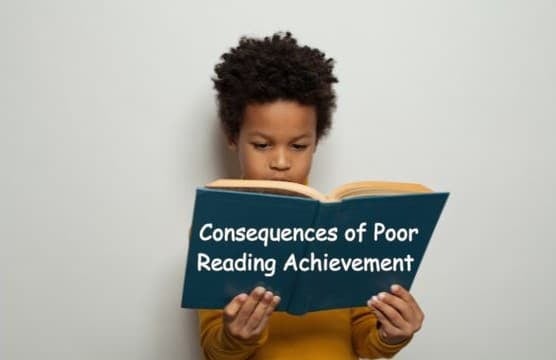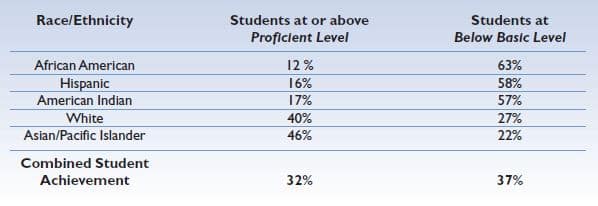
In American schools, too many children struggle to develop the skills necessary to become competent readers. While some children succeed in this endeavor, others do not.
Statistics
Studies show that about five percent of children learn to read nearly effortlessly. Another 20 to 30 percent of children learn to read quite easily once introduced to formal instruction. For the remaining children, learning to read is a formidable challenge, with 17 to 20 percent experiencing substantial difficulties learning to read.
These difficulties exist not because the children are not smart enough but rather because they read too slowly, often due to being poor decoders and lacking fluency, and are unable to remember or understand what has been read.
NAEP 1992 – 2022
Through the National Center for Education Statistics in the U.S. Department of Education, the National Assessment of Educational Progress (NAEP) has been undertaken periodically since 1969. The NAEP reports show that every year since 1992, more than one-third of fourth-grade students were reading at the Below Basic level. The statistics for African American, Hispanic, and American Indian students in the table below paint an even more troubling picture.

The NAEP report of 2022 show no significant difference compared to 1992:

NAEP 2024
The Nation’s Report Card for 2024 states:
- Reading scores are down nationally in both 4th and 8th grades. No state saw reading gains in either grade, compared to 2022.
- A third (33%) of 8th graders are not even reading at the NAEP Basic level—a greater percentage than ever before. Which means, a third of 8th graders likely could not identify basic literary elements in a text such as the order of events, character traits, and main idea.
Reading failure continues into adulthood
Children with reading deficiencies usually become adults with reading deficiencies. The most recent comprehensive data comes from a 2023 study by the Department of Education’s National Center for Education Statistics (NCES). Basic literacy results are grouped into three groups of proficiency: Levels 1, 2, and 3.
Just over half of U.S. adults, 54% or 130 million, are deficient in basic literacy. In 2023, 28% of adults scored at or below Level 1, 29% at Level 2, and 44% at Level 3. Adults scoring in the lowest literacy levels increased nine percent between 2017 and 2023. In 2017, 19% of U.S. adults achieved a Level 1 or below in literacy, while 48% achieved the highest scores at Level 3.
Consequences
If educational and economic achievements are dependent on being a skilled reader, what type of lifetime journey and opportunities can we expect for those without strong reading skills?
Studies have established that the consequences of reading failure go beyond test results and the classroom and cannot be viewed solely as an educational problem. According to expert Reid Lyon,
Anywhere from 10 to 15 percent of children with reading difficulties drop out of school prior to high school graduation. Of those who do graduate, less than two percent attend a four-year college, despite the fact that many are above average in intelligence. A quick survey of adolescents and young adults with histories of delinquent or criminal conduct indicates that approximately half have reading difficulties, and similar rates of reading failure are seen among kids with substance abuse problems. No doubt, occupational and vocational independence and success are compromised.
Literacy experts argue that lower literacy skills mean a lower quality of life and more limited employment opportunities. Data appear to support views reporting that:
★ Respondents in the lowest level of reading achievement reported incomes that were less than half the incomes reported by those in the highest level.
★ While four percent of those in the two highest reading levels reported receiving food stamps, nearly 20 percent of those at the lowest level received food stamps.
★ More than 75 percent of those at the two highest levels reported receiving interest from a bank account, compared to 25 percent at the lowest.
★ Nearly 50 percent of those in the lowest level were living in poverty compared to only four percent for those at the highest level.
★ Slightly more than 50 percent of those performing at the lowest level reported voting in a recent national or state election, compared to 90 percent at the highest level.
Research has proven that there is a close relationship between illiteracy and crime. According to the US Department of Education, 85% of all juvenile offenders have reading problems. In the adult population, 60% of prison inmates are functionally illiterate, meaning that they are unable to read or write well enough to deal with the everyday requirements of life.
Strong reading skills linked to many benefits
On the other hand, strong reading skills have been linked to many personal, social, and economic benefits. According to research published in Psychological Science, reading ability at age seven may be linked to socio-economic status several decades later.
Following more than 17,000 people in England, Scotland, and Wales over about 50 years (from birth in 1958 to the present day), Stuart Ritchie and Timothy Bates of the University of Edinburgh found that participants’ reading and math abilities at age seven were linked to their social class a full 35 years later. Participants who had higher reading and maths skills as children later had higher incomes, better housing, and better jobs in adulthood. The data suggest, for example, that achieving one reading level higher at age seven was associated with a £5,000 (roughly $7,750) increase in income at age 42.
“These findings imply that basic childhood skills, independent of how smart you are, how long you stay in school, or the social class you started off in, will be important throughout your life,” state Ritchie and Bates.
Intervention
Edublox offers live online tutoring that can help stem the tide of illiteracy by helping children and high school students overcome moderate to severe reading difficulties. Our tutoring is effective because it is based on universal learning principles rather than individualized learning styles or personal learning preferences.
Our students are in the United States, Canada, Australia, and elsewhere. Book a free consultation to discuss your child’s learning needs.


